Welcome to the latest edition of our grooming guide tailored specifically for Cavalier King Charles Spaniel enthusiasts in 2024. As we embark on this journey, we recognize the unique charm and elegance these companions bring into our lives. Beyond their regal appearance lies a devotion that deserves thoughtful care, and grooming plays a pivotal role in ensuring the well-being of these beloved furry friends.
In this comprehensive guide, we delve into the intricacies of grooming practices, unveiling a curated set of techniques and tips designed to keep Cavalier not only looking fabulous but also feeling their absolute best. From brushing to bathing, nail clipping to dental care, each step is meticulously outlined to simplify the grooming process and create moments of joy for both you as a groomer and the cherished Cavalier.
Our guide extends beyond the physical aspects of grooming a cavalier king charles spaniel, emphasising the significance of positive reinforcement, regular vet checkups, and troubleshooting common challenges. It's an invitation to transform grooming sessions into a bonding experience, fostering a relationship built on trust, patience, and shared delight.
Understanding Cavalier King Charles Spaniel Coat Types
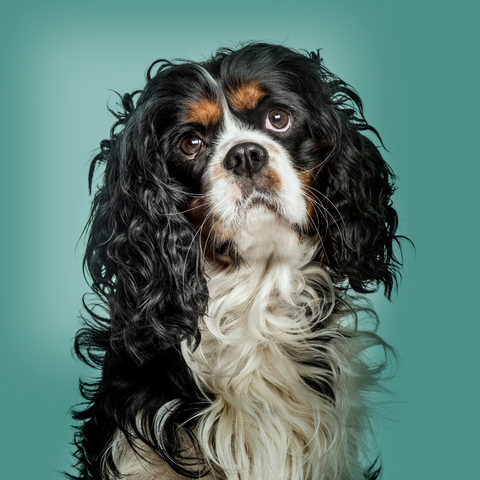
Cavalier King Charles Spaniels are renowned for their charming personalities and elegant appearance, with their distinct coat types adding to their allure. Knowing the characteristics of different coat variations allows them to tailor grooming cavalier king Charles spaniel routines to their specific needs. Here's an insightful look into the common coat types of the beloved Cavalier King Charles Spaniel dog grooming:
1. Blenheim
- Description: Blenheim Cavaliers exhibit chestnut markings on a pearly white background. The chestnut often covers the ears and back, creating a unique and eye-catching appearance.
- Coat Texture: Silky and medium-length.
2. Tricolour
- Description: Tricolor Cavaliers display a combination of black, white, and tan. Black covers most of the coat, with tan markings on the face, chest, and paws, accompanied by white accents.
- Coat Texture: Silky and medium-length.
3. Black and Tan
- Description: Black and Tan Cavaliers showcase a predominantly black coat with tan markings on the face, chest, paws, and inside the ears.
- Coat Texture: Silky and medium-length.
4. Ruby
- Description: Ruby Cavaliers boast a solid chestnut or mahogany-coloured coat without any white markings.
- Coat Texture: Silky and medium-length.
5. Coat Patterns
- Blenheim Spot: Some Cavaliers possess a unique spot on the head, known as the "Blenheim kiss" or "Blenheim spot," adding an extra touch to the Blenheim coat pattern.
- Facial Markings: Recognizable facial markings include the "Blenheim blaze," a white stripe running between the eyes and up to the forehead.
6. Coat Length
Cavaliers typically have medium-length coats that lie flat against the body, with feathering more pronounced on the ears, chest, legs, and tail.
7. Grooming Considerations
Regular brushing is crucial to prevent mats and tangles in the silky coat. Choose grooming products tailored to the specific needs of Cavalier's coat type. Pay extra attention to areas prone to matting, such as behind the ears and under the legs.
Understanding Cavalier King Charles Spaniel's coat type not only enhances their aesthetic appeal but also guides you in providing optimal care. Whether it's the striking Blenheim, classic Tricolour, bold Black and Tan, or rich Ruby, each coat type contributes to the unique beauty of this beloved breed. Regular grooming sessions, tailored to their individual coat requirements, ensure that Cavalier looks and feels their best, embodying the grace and charm characteristic of this delightful breed.
5 Essential Dog Grooming Tools
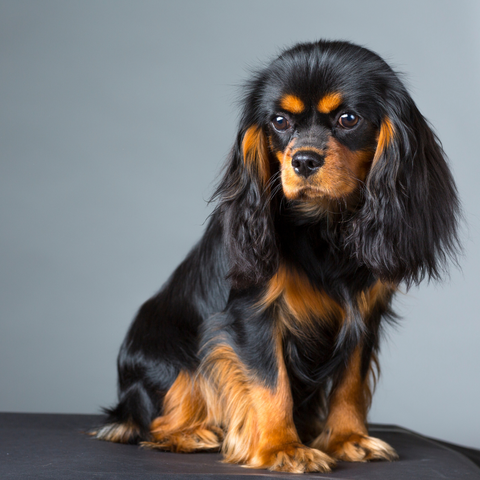
Taking care of a dog's grooming needs are vital for their health and overall well-being. Having the right tools on hand makes the grooming process smoother and more enjoyable for both you and your furry client. Here are five essential dog grooming tools:
1. Brushing Tools
- Slicker Brush: Ideal for removing loose fur, detangling mats, and keeping dog's coat smooth. Choose one with fine, short wires for effective grooming.
- Comb: Versatile for untangling knots, checking for mats, and keeping the coat well-groomed. Wide-tooth combs are great for removing loose fur, while finer-tooth combs handle more intricate tasks.
2. Shampoo and Conditioner
- Dog-Friendly Shampoo: Regular baths are essential for dog's cleanliness. Choose a high-quality dog shampoo appropriate for dog's coat type and specific needs, such as hypoallergenic formulas for sensitive skin.
- Conditioner: Helps maintain a healthy coat by providing moisture and preventing tangles. Choose a conditioner that complements dog's shampoo.
3. Nail Clippers
- Purpose: Regular nail maintenance is crucial for dog's comfort and foot health.
- Key Features: Choose nail clippers based on dog's size and nail thickness. Guillotine-style clippers and scissor-type clippers are common options. Ensure they are sharp for a clean cut without splintering.
4. Ear Cleaning Solutions
- Purpose: Regular ear cleaning helps prevent infections, especially in breeds with floppy ears.
- Key Features: Use a veterinarian-approved ear cleaning solution to gently clean dog's ears. Cotton balls or pads are handy for applying the solution and removing debris. Avoid using cotton swabs, as they can push debris further into the ear canal.
5. Dental Care Products
- Toothbrush and Toothpaste: Dental care is crucial for dog's overall health. Use a dog-friendly toothbrush and toothpaste to maintain good oral hygiene. Regular brushing helps prevent dental issues and keeps dog's breath fresh.
- Dental Chews or Toys: Supplement dog's dental care routine with dental chews or toys designed to reduce plaque and tartar. These can be a tasty and effective way to support oral health.
Regular grooming not only keeps dog looks and feels great but also provides an opportunity to monitor their health. By investing in these essential grooming tools and establishing a consistent grooming routine, you contribute to dog's happiness and well-being.
5 Steps to Cavalier King Charles Spaniel Grooming
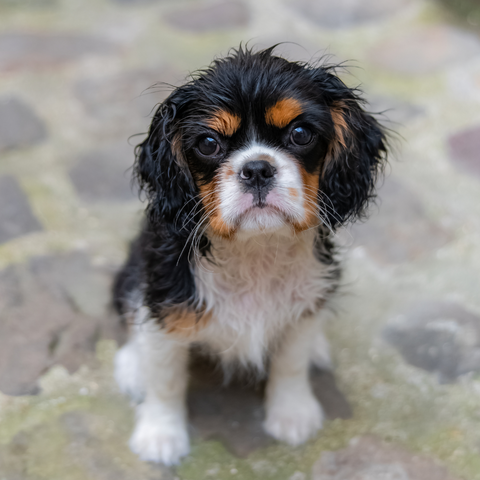
Grooming is an essential aspect of caring for Cavalier King Charles Spaniel, ensuring they look their best while maintaining good health. Follow these five steps for effective and enjoyable grooming sessions:
1. Brushing
- Frequency: Brush Cavalier's coat at least three times a week to prevent mats and tangles.
- Tools: Use a slicker brush and a comb. The slicker brush helps remove loose fur and detangle, while the comb helps maintain a smooth coat.
- Technique: Start from the tips of the fur and work way up, paying attention to areas prone to matting, such as behind the ears and under the legs.
- Frequency: Aim for a bath every 4-6 weeks or as needed. Cavaliers generally don't have a strong odor, so bathing can be less frequent.
- Products: Use a high-quality dog shampoo and conditioner suitable for Cavalier's coat type.
- Technique: Wet dog thoroughly, apply shampoo, and massage gently. Rinse thoroughly to remove all shampoo. Apply conditioner if needed. Dry Cavalier with a towel or a low-heat blow dryer.
- Frequency: Check Cavalier's nails regularly and trim as needed, usually every 2-4 weeks.
- Tools: Choose nail clippers suitable for dog's size. Guillotine-style or scissor-type clippers work well.
- Technique: Trim the tips of the nails, avoiding the quick. If unsure, trim a small amount at a time. If dog has dark nails, use caution to avoid cutting into the quick.
- Frequency: Check Cavalier's ears weekly for signs of redness, odor, or discomfort. Clean as needed.
- Tools: Use a veterinarian-approved ear cleaning solution and cotton balls.
- Technique: Apply the ear cleaning solution to a cotton ball and gently clean the ear, avoiding the ear canal. Do not use cotton swabs, as they can push debris further into the ear.
- Frequency: Brush Cavalier's teeth regularly, ideally every day or at least 2-3 times a week.
- Tools: Use a dog-friendly toothbrush and toothpaste. Dental chews or toys can also supplement a dog's oral care.
- Technique: Gently lift dog's lips and brush the teeth using a circular motion. Be patient and use positive reinforcement. Dental chews or toys can help reduce plaque and tartar.
Handling Special Grooming Considerations
Grooming considerations can vary based on factors such as seasonal coat changes and shedding patterns. Understanding and addressing these specific needs ensure dog's coat remains healthy and well-maintained. Here's how to handle these special grooming considerations:
1. Seasonal Coat Changes
Understanding the Cycle
- Dogs often undergo seasonal coat changes, shedding more during certain times of the year.
- Recognize when dog typically experiences shedding, which can vary by breed and individual factors.
Increased Brushing
- During shedding seasons, increase the frequency of brushing to remove loose fur and help control shedding.
- Use a deshedding tool or brush designed for dog's coat type to effectively remove the undercoat.
Regular Baths
- Baths can help control shedding by removing loose fur and promoting a healthy coat.
- Use a high-quality dog shampoo and conditioner appropriate for dog's coat during bath sessions.
Consultation with a Professional Groomer
- If shedding is excessive, consider consulting with a professional groomer who can provide specific advice and grooming techniques.
2. Dealing with Shedding
Regular Brushing Routine
- Establish a regular brushing routine to prevent matting and control shedding.
- Use a slicker brush or deshedding tool to remove loose fur effectively.
Supplement with a Healthy Diet
- Ensure dogs receive a balanced and nutritious diet to support coat health.
- Consult with a veterinarian to determine if dietary adjustments or supplements are needed.
Professional Grooming Sessions
- Schedule professional grooming sessions, especially during peak shedding seasons.
- Professional groomers can provide thorough deshedding treatments to manage excessive shedding.
Manage Environmental Factors
- Maintain a clean living environment to reduce the accumulation of fur.
- Use air purifiers and regular vacuuming to minimise the impact of shedding on indoor spaces.
Regular Health Checks
- Monitor dog's overall health, as excessive shedding can sometimes indicate underlying health issues.
- If shedding appears unusual or is accompanied by other concerning symptoms, consult with a veterinarian.
Consider Breed-Specific Factors
- Understand that shedding patterns can vary significantly among different breeds.
- Research and be aware of the typical shedding behaviour for dog's breed.
Tips for Keeping Cavalier Comfortable
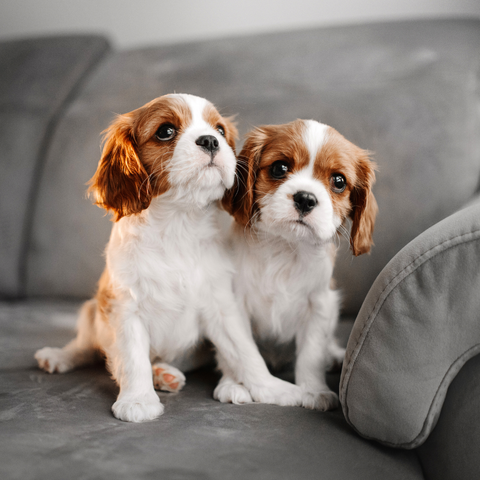
Ensuring the comfort of Cavalier King Charles Spaniel involves more than just grooming. It's about creating a positive environment and maintaining their overall well-being. Here are essential tips to keep Cavalier comfortable and content:
1. Positive Reinforcement
Gentle Grooming Sessions
- Use positive reinforcement during grooming, such as treats and praise, to create a positive association.
- Keep grooming sessions short and enjoyable to prevent stress.
Reward Good Behavior
- Reward Cavalier for good behavior, whether during grooming, training, or daily activities.
- Positive reinforcement strengthens the bond between you and dog.
Create a Comfortable Space
- Provide a cosy and comfortable space for Cavalier to relax and unwind.
- Use soft bedding, blankets, and toys to make their resting areas inviting.
2. Regular Vet Checkups
Routine Health Assessments
- Schedule regular vet checkups to monitor Cavalier's overall health.
- Regular vaccinations, dental checkups, and preventative care are essential for a healthy and happy dog.
Address Health Concerns Promptly
- If you notice any changes in behaviour, appetite, or activity level, consult with veterinarian promptly.
- Early detection and treatment of health issues contribute to dog's well-being.
Dental Care
- Incorporate dental care into routine. Regular brushing, dental chews, or toys help maintain good oral health.
- Dental issues can impact dog's comfort and overall health.
3. Monitoring Skin and Coat Health
Regular Coat Checks
- Regularly check Cavalier's coat for signs of dryness, irritation, or unusual lumps.
- Grooming sessions provide an opportunity to assess the condition of their skin and coat.
Use Appropriate Grooming Products
- Choose grooming products suitable for Cavalier's coat type and skin sensitivity.
- Avoid harsh chemicals and opt for hypoallergenic options if needed.
Address Allergies or Sensitivities
- If Cavalier displays signs of allergies or skin sensitivities, consult with vet.
- They can recommend appropriate grooming products and allergy management strategies.
Proper Nutrition
- Ensure Cavalier receives a balanced diet that supports skin and coat health.
- High-quality dog food with essential nutrients contributes to a shiny and healthy coat.
By incorporating these tips into the care routine, contribute to the overall comfort and well-being of Cavalier King Charles Spaniel. A happy and comfortable dog is more likely to thrive, enjoying a fulfilling life as cherished companion.
Troubleshooting Common Grooming Challenges
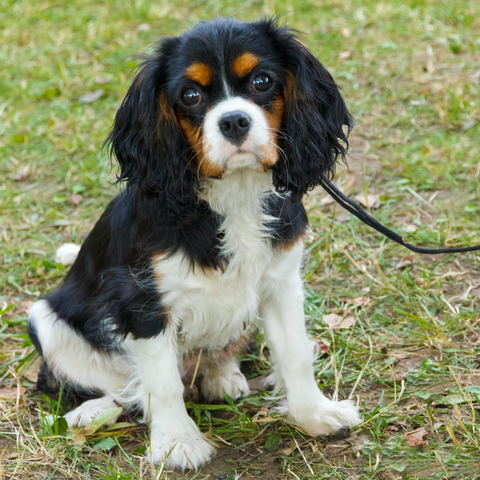
Grooming challenges are not uncommon, and understanding how to troubleshoot them ensures a positive and effective grooming experience for a furry. Here are solutions for three common grooming challenges:
1. Excessive Shedding
Increased Brushing
- Solution: If the dog is shedding excessively, increase the frequency of brushing sessions. Use a deshedding tool to remove loose fur effectively.
- Prevention: Establish a regular brushing routine, especially during shedding seasons, to control loose hair and prevent matting.
Balanced Diet
- Solution: Ensure dogs receive a balanced and nutritious diet. Dietary deficiencies can contribute to excessive shedding.
- Prevention: Consult with a veterinarian to determine the most suitable diet for a dog's specific needs.
Professional Grooming
- Solution: Schedule professional grooming sessions, especially during peak shedding seasons. Professional groomers can provide thorough deshedding treatments.
- Prevention: Regular professional grooming helps manage shedding and keeps the dog's coat in optimal condition.
2. Skin Irritations
Use Hypoallergenic Products
- Solution: If a dog experiences skin irritations, switch to hypoallergenic grooming products. These products are gentler on sensitive skin.
- Prevention: Choose grooming products carefully, considering the dog's specific skin type and any known allergies.
Regular Health Checks
- Solution: Monitor dog's skin for signs of redness, rashes, or dryness. If you notice any issues, consult with a veterinarian promptly.
- Prevention: Regular grooming sessions provide an opportunity to inspect dog's skin and catch potential issues early on.
Adjust Grooming Frequency
- Solution: If a dog has skin sensitivities, consider adjusting the frequency of grooming sessions. Less frequent grooming may be suitable for dogs with sensitive skin.
- Prevention: Develop a grooming routine that suits the dog's individual needs, taking into account their coat type and skin sensitivity.
3. Resistant Behaviour
Positive Reinforcement
- Solution: Use positive reinforcement during grooming sessions. Reward good behaviour with treats and praise to create a positive association.
- Prevention: Make grooming a positive and enjoyable experience from the start, using treats and praise consistently.
Short, Positive Sessions
- Solution: Keep grooming sessions short and positive, gradually increasing the duration as dog becomes more comfortable.
- Prevention: Start grooming routines early in dog's life to build positive associations and prevent resistance.
Consult with a Professional Trainer
- Solution: If resistance persists, consult with a professional dog trainer. They can provide guidance on addressing behavioural challenges during grooming.
- Prevention: Early socialisation and positive reinforcement contribute to a dog's overall comfort with grooming activities.
By addressing these common grooming challenges with patience, consistency, and the right approach, you ensure that grooming remains a positive and beneficial experience for dog. Regular grooming not only maintains their physical health but also strengthens the bond between you and furry companion.
Conclusion
In concluding grooming Cavalier King Charles Spaniels in 2024, it's evident that the well-being of these charming companions goes beyond a mere beauty regimen. Grooming is a holistic practice that fosters both physical health and the unique bond. By following the outlined steps in this guide, you not only enhance the aesthetic appeal of Cavalier but also contribute to their overall comfort and happiness. From brushing and bathing to nail clipping and dental care, each step is a proactive measure in ensuring a vibrant and joyful life for beloved pet.
Regular vet checkups, monitoring skin and coat health, and troubleshooting common grooming challenges are vital components of a comprehensive care routine. These practices not only address immediate concerns but also contribute to the preventive care that is essential for Cavalier's long-term well-being.

